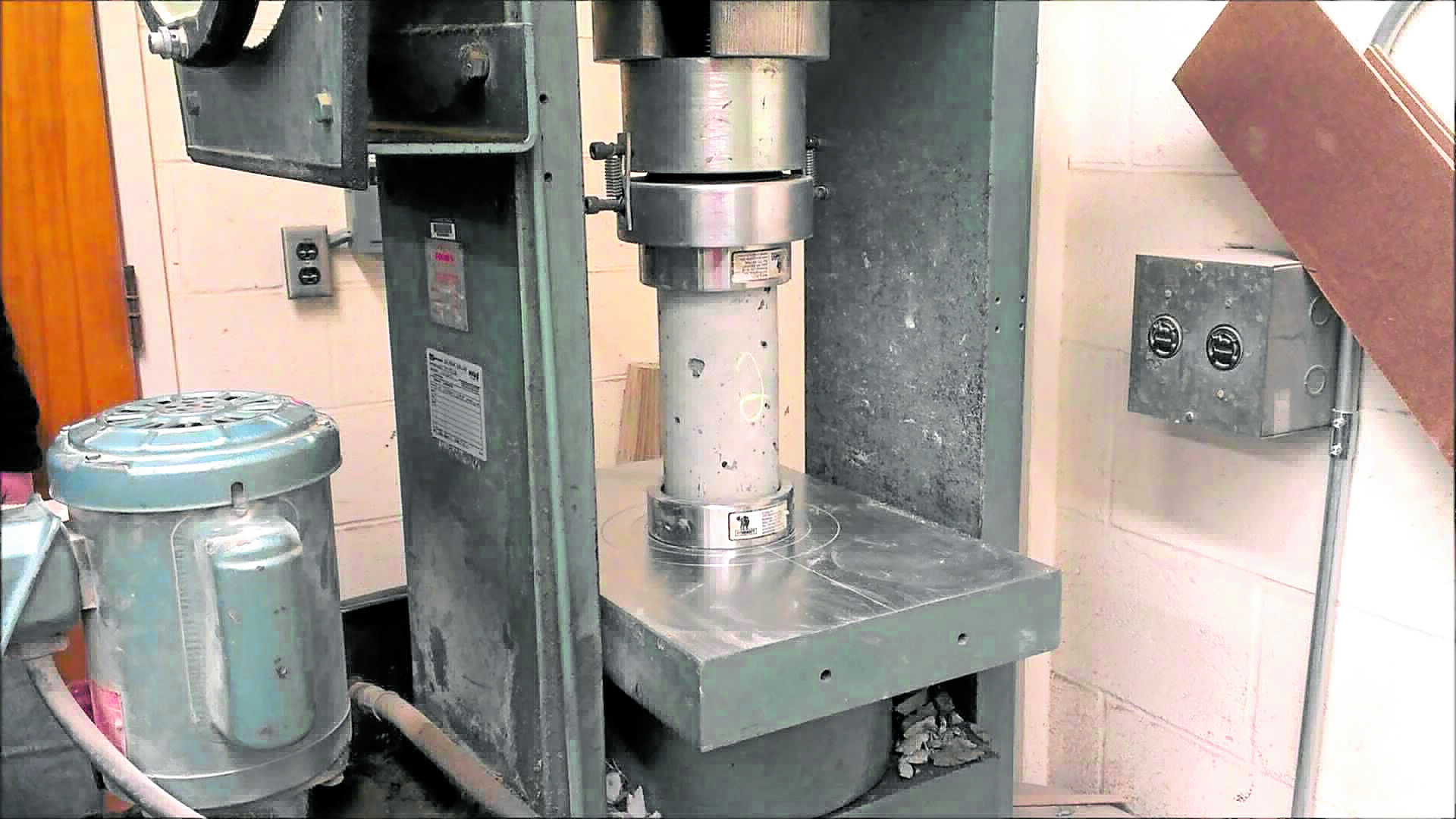35 practical tips on preparedness

We are all hoping the coming year will be kinder. And while we ponder over what can be done better, let’s have a look at how we can prepare ourselves for one of our long-term challenges: climate change. The world is naturally evolving at its own will, just as it has in the past millions of years. As it goes through its cycles, there are many things we cannot prevent. However, we can certainly do our part to reverse the many man-made changes that have, in turn, caused losses in property and life.
Having said that, here is a 35-point list of practical tips for living within one of the most catastrophe-prone areas in the world. I am a realistic-optimist. While I would like to think 2021 will be better year, there is always merit in being prepared for the worst.

Concrete samples in cylindrical form undergo compression testing to determine the actual strength of mixed batch of concrete.
1 Put together and designate a space for your “disaster kit”, an assembly of tools and materials that can be used for moving or removing debris, sorting through rubble. This would include equipment like crowbars, construction gloves, rubber gloves, a car jack, shovels, rope, large hammer, extra batteries, whistle, flares or light sticks, headlamps, a battery-operated radio and a fire extinguisher. Make sure everyone in the household is familiar with this designated space.
2 Hang up and secure of your emergency “Go-Bags”. You need to have an area where these personal bags or backpacks are quick to grab. A go-bag is a personal survival kit that should sustain you for the next two to four days, or until help is on the way. This would include items like prescription medicines, extra clothes, some cash, blankets, a first aid kit, extra car and house keys, power bars, dry food, a personal knife, a small multi-tool, purification tablets for water, canned food, sanitizer, toilet paper, and others you would deem personal essentials.
3 When looking at a property, do ample research on available historical data on earthquakes, flood levels, and other indicators. Go around the property and its community for signs of previous or potential disasters. This is most essential if you are looking at areas situated along the sides of hills or mountains, or within valleys, or beside water bodies. Consider flooding, mudslides, and landslides during heavy rains; tsunamis and liquefaction during earthquakes; and potential ashfall from nearby slumbering, but active, volcanoes.
4 Plant and cultivate endemic, native hardwood trees in your property–even fruit-bearing trees too. They not only help keep your ground stable, they also absorb a large amount of water–some 1,500 to 2,000 liters–from the ground, and help keep the water table up. Moreover, trees hold soil particles together and reduce erosion. Trees slow the impact of winds and water. Local bamboos curb floods and erosions (notice how they like to grow wildly near streams and rivers) while vetiver grass has a deep root system that keeps steep slopes stable. Trees also encourage the development of the ecosystem in your backyard. Think bees, butterflies, birds, bats and bugs –all important for the replenishment of ground nutrients and the circle of life.
5 When planning your outdoor spaces, use permeable paving material for driveways, open decks and walkways instead of solid pavings. Allow water to naturally go back into the ground rather than burdening drainage systems, water catchments or riverways. Also consider your own water retention systems, your small reservoir of rainwater, stored for future use like washing down large areas and for irrigation.
6 Test your structural materials for strength. Make sure that the concrete mixtures for your footings, columns and slabs undergo a cylinder test to confirm that the compressive strength of the concrete meets the specifications for the PSI strength it was designed for. You’d be surprised how much of a variance there can be in the mixture.

Permeable pavers and green spaces allow water to naturally go back into the water table, rather than being directed into storm drains.
7 Take it a step further and check your rebar sizes for accuracy and ask for a certification. During an earthquake, it is the tensile strength of your reinforcement bars that support the lateral movement. In past experiences, some of the most commonly sold rebar sizes were substandard in size after they were measured with a caliper. Also ask your supplier or the mill for a certification of its size and strength and the mixture of the alloy.
8 Prior to the concrete pouring of beams and slabs, ask your structural engineer to check the installations. Have them validate that the bars are spaced properly and tied together, up to specifications. Ensure that the construction work is in conformity to the structural design. These “hidden” mistakes can spell the difference in the integrity of a structure.
9 If you are building a lightweight structure or something made with the frame and panel system, look into the mobility of joints and the flexibility of the material. A certain degree of swaying is better than too much rigidity as building parts can just snap and be blown away.
10 The shape of your structure can also affect strength. All things being equal, regularly shaped and balanced square structures will be able to withstand natural forces better than one that has too many corners, or one that is too elongated. For this reason, most of our buildings are designed with the elevator core in the center, keeping structures balanced and anchored in the center. And those that have them asymmetrically located, do spend more for ensuring structural stability
11 Check roofing installation methods over the material itself. I’ve seen heavy cement or clay tiles ripped-off by strong winds because they were not installed properly. For long span roof systems, winds are able to peel them away through open gaps between sheets and flashings, so it would just be wise to ensure that enough rivets keep these joints close together with a reasonable amount of sealant.
12 The same goes with the roof framing: the reason you hear of entire roofs flying off is because their frames or trusses are not properly fixed to the main structure. The size of your trusses and framing does not dictate the system’s strength alone. Rather, it is also the way it is attached to the rest of the structure like your columns and roof beams, that does. Use additional plates and straps, more joists and joist hangers, and check for the proper lengths of bolts and screws.

Stackable chairs are space-saving, usually lightweight and easy to relocate. Use weatherproof material to last through many typhoons. —KETTAL
13 Design your roof gutters to be oversized. Previously, people were happy with eight- to 10-inch-wide gutters. However, the large amount of rainfall we have been experiencing has increased standards to a foot or even more the for larger roof systems. Needless to say, keeping them protected with a mesh helps keep leaves and debris from clogging the system.
14 Ensure that roof downspouts are substantially sized and are frequently or closely spaced. Consider the fact that we have such things like dried leaves jamming our gutters, and also the occasional ashfall. In which case, make sure that all the the storm drain catchments that your downspouts pour into can be opened and are accessibl.
15 This goes as well with flat roofs: if anything, invest in a very good waterproofing system, as winds have become stronger and they put a lot of pressure into small leaks which find their way into the smallest nooks and travel through your slabs. Increase the quantity of roof drains and install trenches to avoid flooding. In a calamity zone of high-intensity winds, this is a better option than sloped roof systems.
16 With the threat of a flood or a typhoon, bring all your outdoor furnishings inside. If you can’t, make sure to tie them together to keep them from rattling away with wind, or worse, floating away with the flood. Use of a strong cotton cord or even our local straw tali, which works better than the textural and abrasive nylon cord.
17 In your outdoor spaces, avoid installing accessories that can be swayed and pulled. That includes ceiling fans that drop quite low, or lights that hang by a rope or chain. If you have any of these, make sure they are properly anchored inside your ceiling–and not only to the ceiling structure itself but to the slab above it as well.
18 As our typhoons have become stronger, ensure that your door and window systems can withstand at least 250 kph of winds or more, in terms of both water tightness and structural stability. Leaks can damage other finishes in your interior, while an unstable system can loosen during a typhoon. Installing roll-down metal shutters outside glass windows is another way to protect your existing window systems.

Open shelving with large and heavy objects may not be a good idea if you live on a high floor. —LUXXO
19 Make sure that your window frames have bolts that go deep into your window frames or openings. We’ve seen footage of frames being ripped away from a wall during strong typhoons because of sub-standard fixing methods.
20 Ensure that the thickness of your glass panels are commensurate to their panel sizes. We’ve seen large windows and sliding doors using only 6mm thick glass, easy to shatter and rip off from the frames. The last thing you’d want as winds and rains rage, is an open door or window that can’t be shut.
21 Explore using either laminated glass (which holds together when broken) and tempered glass (which is stronger but shatters into bits when it breaks) for different areas–the former for where you have glass panels close to habitable areas like bedrooms, and the latter for more exposed areas that are prone to getting hit by flying debris or fallen branches or trees. Also, explore specialty films by companies like 3M, with sticker systems that render your windows strong against these winds.
22 Using masking tape to keep your window panels from shattering is an absolute myth. It is paper, and paper rips. However, if you think your glass panels are sub-standard and you are at risk of the glass shattering, tape them diagonally across window frames using duct tape. It may not keep your glass from breaking, but it will help hold it together in case of breakage. No one likes flying shards.
23 When designing your homes, locate your main power switch in the inner parts and not at the perimeter rooms of the structure, keeping it away from windows and other areas that could be susceptible to flooding or being exposed to moisture or rain. If possible, locate on the second level if your property is flood prone. Cleaning up a panel board takes too much effort and requires substantial drying time.
24 Design your power system in such a way that you can segregate floors or areas–especially if you are prone to flooding, or in case certain structures could break apart during an earthquake. Keep a diagram of your circuit breaker with labels identified per circuit, available for easy powering on or off.
25 Secure large appliances (like refrigerators, water heaters, and stoves) with flexible cable, braided wire, or metal strapping, if you are flood prone. Some appliances, especially those without complicated digital systems, are practically wash and wear, but can float away and destroy other things if not anchored. Strap in your tank type water heater and attach it with wall brackets.
26 Because earthquakes can strike anytime, secure all loose items, more especially if you live on a high floor. Install catches on your closet and cabinet doors, putting emphasis on the overhead ones, adding locks for those you hardly open. Secure artwork and mirrors, and remove heavy and unstable items from any high shelves.
27 Despite having a good regular supply of water, have a water tank for emergencies. The rule is: one gallon per person, per day, for an anticipated emergency period of three days–only for consumption and excluding the volume for bathing. To avoid water going stale, connect the tank to a utility or garden bib that is frequently used, so that the water doesn’t go stale and is continuously used and replenished.
28 If you use gas tanks for cooking, make sure that your tanks are strapped secure. Include the supply pipes, and make sure to shut them off at the arrival of a typhoon or threat of a flood. Shut off the valves when not in use.
29 If your gas lines are piped throughout your different cooking equipment, including gas-fired water heaters, make sure to have the proper shut-off valves. This is especially important for earthquakes wherein movement can make the gas lines snap. Make sure too that everyone in a household knows how to shut off the main gas valve.
30 If you have suffered through a typhoon or flood, do not activate your or energize your power system until you have cleaned out water from your floors. Consider especially any floor-mounted power outlets and lower level wall power outlets. If you suspect water has gotten into your conduits, open up all your switches and outlets, then flush out any water from the conduits using an air compressor, use the less powerful ones used for pumping up bike tires, or better yet, those larger units used by painters when spraying paint.
31 If your interior or exterior walls have been reached by flood water, wash them down immediately. Mild detergent or a strong laundry soap bar should be used. Most floodwaters also contain silt, oils, and other chemical compounds that can stain your material finishes if left to soak for some time. Do not use too much pressure as you can scour out the paint finish or discolor the material.
32 When dealing with natural stone finishes, make sure to wash and dry them out immediately. Grouting not only makes your stone look finished and properly installed, it also protects against the absorption of stains. So during the dry season, check that you have the proper grouts and sealants in place.
33 If you live in a flood-prone area, “waterproof “ your vulnerable areas by using materials that stay unaffected by water. Instead of medium density fiberboards or plywood for your cabinetry, use high-density PVC boards; instead of painted timber baseboards, opt for pre-cast concrete; instead of real veneers (yes, this is where it gets sad) use synthetic laminates. Given how well they are manufactured, only a trained eye can tell the difference.
34 In your service spaces, identify poisons, solvents, or toxic materials. Keep them in unbreakable containers and move these containers to a safe, well-ventilated storage area. A well-ventilated concrete enclosure is best. Keep them away from your water storage, out of reach of children and pets, and away from areas where they can potentially be crushed and containers broken.
35 Unburden your spaces–and mother nature–by living minimally. It will not only give you more space, it will also help regenerate nature and bring our ecosystem and the biosphere back into balance.



